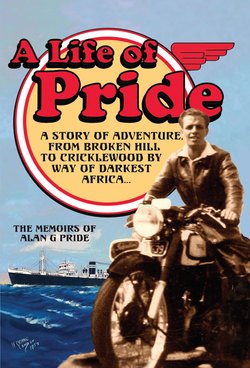Читать книгу A Life of Pride - Alan G Pride - Страница 6
На сайте Литреса книга снята с продажи.
Chapter 1
Born in the 1930s
ОглавлениеI came into the world in the front room of my parents’ house, on the 29th August, 1930—the same month as the arch of the Sydney Harbour Bridge was first closed.
In those days most people were born at home, with a nurse at hand if their parents could afford one. Mine was called Sister Carwithen.
We lived at 307 Oxide Street, in the western NSW town of Broken Hill. An isolated desert settlement, it was based on the mining of silver, lead and zinc, and most people worked in the mines or in businesses servicing them; even the streets were named after minerals. The population in the 1930s was about 30,000 people, living in houses of stone, brick or corrugated iron (uninsulated!) Many streets further away from the town centre were just dirt, dust blew everywhere, goats and rabbits roamed freely, and water was always scarce.
My father, Reg Pride, was a mining engineer. My mother, Ethel, had been a dental nurse before marriage. Both of them enjoyed a better standard of living than their parents' – Dad came from a crowded house in the working-class Sydney district of Balmain; Mum’s mother, Sophia, had arrived in Broken Hill in a bullock-wagon.
Her family had left Cornwall in 1865, sailing on the Lincoln to Adelaide in South Australia, and from there working their way through the desert, ending up in Broken Hill 500 kilometres to the north-east.. Their first Broken Hill home on arrival in 1885 had been a tent on the corner of Chloride and Beryl streets, and their lives were hard, working in the mines and dying of diseases curable today. (Her elder sister Elizabeth had died at sea on the voyage out, of meningitis, and another four of her ten siblings died young; of whooping cough, kidney failure, 'atrophy', and more meningitis. She lost her own husband, son and mother over a seven-year period— her husband, James Barnes, dying at 43 from 'pulmonary phthisis', aka 'dust on the lungs' after a working life spent down mines.) My mother, like myself, was born at home, in a miner's cottage in Mica Street.
Our home was a big brick and stone place with a cellar underneath, lawn and flowerbeds out the front, a red-dirt backyard with a chook pen and clothesline, and an outside dunny.
Soon after my birth, Dad went to New Guinea to supervise the installation of mining machinery. Mum and I joined him when I was four, while my older sisters, Gloria and Audrey, were looked after back home by Sophia (whom we kids called “Narna”) when not at boarding school in Adelaide.
Our Wau home with Mum on the verandah, me below on Dad’s Triumph.
Our servants were three New Guinea men: Mickey, the cook; Sarpi, the houseboy, and Boko. They called me Liklik (little) Master, and taught me to swim by throwing me into a nearby river with a rope tied around my waist! I soon learned Pidgin English and chattered away to them, while they carried me on their shoulders.
Mum blithely captioned this photo - “My two Coons - Mickey and Sarpi with Alan - just look at the length of their arms!”
Our New Guinea home was a colonial-style building on stilts, right beside Wau Airport. I think Mum quite enjoyed it, as we had servants and she would be carried in a sedan chair when we were invited to the natives’ ‘sing-sing’.
Wau Airfield was very busy, with planes always coming and going. I watched them eagerly from our front verandah and garden and one day I witnessed a crash. Running inside, I yelled to my mother, “Bigpella balusi, himall buggerup finish!” ('Balusi' being pidgin for plane.)
There was a gold-rush on in New Guinea in the 1930s, made worse by the Depression, with lots of Australian men coming up to look for gold. The Leahy brothers were adventurous prospectors who explored a lot of the Highlands at the time, meeting tribes who had never seen white people. In 1983, the film, ‘First Contact’ was made about them and at one point it shows old footage of a mining engineer, being brought to their camp by plane “from Wau”, to assess the site. I think this is my father! The man has his build, posture and usual clothing and it was filmed at the time when he was certainly doing this sort of work in New Guinea.
We went back to Australia in about 1935 on the Strathnaver, probably so that I could start school. The kindergarten in Morgan Street was close to home, but all I remember about it is the name of my teacher, Maisie Britts, and the fact that she came to school in a Willys Jeep. (Obviously I was already interested in cars.)
Ethel and Alan with Mickey and Boko, December 1934.
